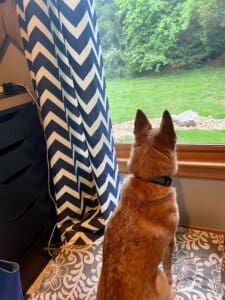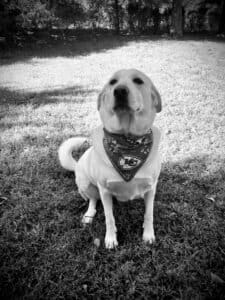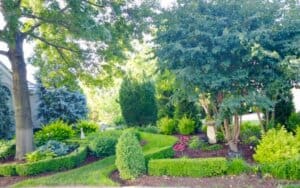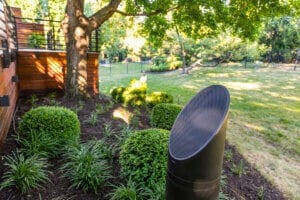Today, many Kansas City homeowners are looking to spend more time outside.
The boosted mood and spike in Vitamin D from the sunshine – not to mention the reduced stress – is enough to draw anyone outdoors.
Whether you use your yard as a quiet space to relax or a major outdoor entertainment space, spending time with family and friends is a big priority. And your family and friends naturally includes your furry companions.
Your dog is your best friend, so why not design your backyard with your four-legged friend in mind?
You want dog-friendly landscaping that suits your needs, but also incorporates spaces for your pet that make sense for your pet’s safety and your sanity.
Consider these backyard ideas for dogs in Kansas City so you can better articulate your vision to your landscape professional.

Landscaping for Dogs: 6 Key Ideas
You might be wondering why dog-friendly landscaping is such a trend for Kansas City home landscapes today. Upward of 45% of people in Missouri own a dog, according to World Population Review, so it’s certainly on nearly half of homeowners’ minds.
So naturally they want to create a place that is aesthetically pleasing and functional for themselves, but also gives their beloved dogs places to enjoy the outdoors.
Try these ideas when seeking yards for dogs that serve multiple purposes.
1. Pet-Friendly Plants
Plants are a key concern when you’re landscaping for dogs. You want to choose plants that are non-toxic for your pets or can handle pet traffic.
Some options for pet-safe plants include:
-
Many Ornamental Grasses – A variety of ornamental grasses are pet-safe. Maidengrass, for instance, with its long, narrow leaf blades are hardy, durable, and low maintenance. Your dog can run near and through them safely.
-
Forsythia – Forsythia flowers are densely packed in tight golden yellow clusters along the entire length of the stem. They are not toxic, so if your dog eats fallen flowers, it’s ok.
-
Magnolia – Most magnolia bushes offer spectacular flowers in purple, pink, or white, and they are dog-friendly landscaping options. They do well in full sun.
-
Creeping Phlox – Creeping phlox has dainty flowers that can thrive in challenging sites, like slopes, rocky areas, and borders. It can form a lush carpet of foliage and flowers that are non-toxic.
-
Roses – You might be surprised to find roses on a list of dog-friendly landscaping. Sure, roses have thorns, but you can plant them strategically as a barrier to keep your dog out of landscape beds. Plus, they are non-toxic if your dog were to chew on them.
-
Coral Bells – Coral bells grow low mounds of leaves in a range of shades from bright green to warm orange to deep purple with small sprigs of tiny flowers on long stems waving above. All parts of this plant are non-toxic.
-
Black-eyed Susan – Looking for golden yellow color later in the season? Try black-eyed Susan. You and your dog can enjoy many cheerful blooms in late summer.
-
Tickseed – Tickseed, or coreopsis, has non-stop blooms that continue without deadheading. And this hardy plant is safe for your dog. Also, don’t worry about the name; this plant doesn’t draw ticks. It gets its name from its small dark seeds that resemble bugs.
-
Astilbe – Astilbe adds whimsical texture with fluffy flower spikes on dark, fern-like foliage. It thrives in shady areas, and is non-toxic and low maintenance.
On the opposite side of the plant spectrum, you want to avoid toxic plants. The American Society for the Prevention of Cruelty to Animals has lists of toxic plants for dogs and cats. Some specific ones to note include:
-
Tulip Bulbs – Tulip flowers have a cup shape. The bulb is most toxic to pets, but the leaves can upset their stomachs, too.
-
Lily of the Valley – Sweet-smelling woodland plant that thrives in shade with white, bell-shaped flowers. The entire plant is toxic.
-
Azalea and Rhododendrons – Fragrant, flowering shrubs with funnel-shaped flowers ranging from pink to red to yellow to purple. The whole plant is toxic.
-
Yews – Commonly used as hedges, ranging from 2.5 feet to more than 50 feet high. Its leaves, seeds, and bark are toxic.
-
Chrysanthemums – These common flowers contain lactones and pyrethrin, which can cause intestinal irritation. While not lethal, if your dog eats any part of the plant it can suffer vomiting, diarrhea, excessive drooling, and skin rashes.
-
Ivy – English ivy, or common ivy, grows as a vine and is typically used as a ground cover.
-
Foxglove – All parts of these tall beautiful flowers, from the seeds to the petals, are extremely toxic to dogs. Ingestion can cause cardiac failure and even death.
-
Holly – Although some varieties are less toxic than others, it is best to keep your dog away from any variety. Eating the leaves can result in vomiting, diarrhea, and gastrointestinal injury due to the plant’s spiny leaves.
-
Sago Palms – The sago palm is a popular ornamental plant because it looks like a miniature palm tree. In Kansas City, it’s used mostly in containers during warmer months. Its seeds and nuts are most toxic, but the leaves and bark are poisonous, too.
2. Pet-Centric Landscape Design
Another important part of dog-friendly landscaping is thinking about your pet in your garden design.
And just like us, dogs need exercise and space to play.
Some of the ways you can include your pet in your landscape design include:
-
Include potty/waste spaces and waste removal storage.
-
Incorporate pet play spaces, including lawn areas and shallow water features made for pets that use a different liner that can hold up to their paws and claws.
-
A dog-proof backyard will also involve intentional spacing of plants to allow or eliminate access to specific areas.
-
Dogs need shade or shelter to relax and cool off, especially in the warmer months. Shade trees and dog houses can work.
-
Your pet will also need access to clean water regularly.
3. Mix Spaces for You and Pets
You can be creative in your quest to create landscaping for dogs.
Try these innovative ideas to get something that combines a space for you and for your furry friend.
-
After playing a round of fetch in the hot sun, there’s no better way for a dog to cool off than splashing around in a pool or fountain. Dual-use water features, such as bubbling rocks or bubblers with shallow water, can serve as safe watering spots for pets and can also be artistic elements in your landscape. Pro tip: Ensure the water is treated with pet-safe products.
-
Dogs love to explore and patrol their territories. In your backyard, though, walking the same path over and over again can trample the grass and compacts the soil. Integrating pathways into your landscape design can entertain dogs and define portions of your landscape, keeping dogs away from your flower beds. Dog paths for your pet can even double as walking paths for your family. You can even incorporate dual-use dog-runs that function for dog play and can convert to a bocce court when you’re entertaining family and friends.
-
Want to add a dog house, but don’t want it to be an eyesore? Creating an outdoor kitchen or bar with a hidden dog house spot on the back side for pets to relax. Or try creating a custom dog house with a green roof that can be pretty or function as a raised herb garden.
-
Landscape lighting can be a great addition for you to enjoy the outdoors longer, as well as enable you to better see your pet when you let him or her outside after dark.

4. Avoid Common Dog Hazards
You can’t create a dog-proof backyard without avoiding some things that can hurt dogs or create additional mess for you.
Avoid toxic weed killers and lawn and landscape chemicals, opting for pet-safe options. Not only will this keep your pet safe but it will prevent them tracking these products into your home as well.
Also avoid things that can easily get stuck in your dog’s paws and be tracked into your home, such as small pebbles, finely ground mulches, or needles and seed pods that can stick to their fur.
5. Eliminate Digging Spots
While nothing can 100% deter digging in regards to your landscape design, you can prevent digging with consistent training and behavioral redirection.
Some dog-friendly landscaping tactics can help. Barriers and protective guards can help prevent digging damage, for instance. Barriers can include below-ground chicken wire mesh or weed or barrier fabric or they can be gates, fences, or trellises.
In areas where dogs like to dig, try using 2- to 4-inch rocks as a cover to help prevent this.
6. Take Proper Care of Your Landscape
Some landscape professionals offer landscape maintenance that helps yards for dogs in Kansas City.
For instance, High Prairie is developing a Pet Program in our Garden Care division. This program is tailored toward pet owners who struggle with the common challenges associated with pets in the landscape. The High Prairie Pet program will include:
-
More seeding, using High Prairie’s custom seeding blend.
-
Turf alternative options in heavy traffic pet areas, such as clover lawns and artificial turf pockets.
-
Soil treatments to help remove excess ammonia and waste build-up from soil.
-
Low-toxic chemicals for turf.
-
Low-toxic weed prevention with no glyphosate.
-
Dog waste removal.
These types of care programs are designed to overcome common pet frustrations like waste build-up in the soil, muddy areas, plant parts or mulch that stick to fur and get tracked inside, and small pebbles that get tracked inside.
Embrace Dog-Friendly Landscaping in Kansas City
When designing a yard for dogs, you want low toxicity and high durability. You want to think about their needs, as well as your own.
We know this can be challenging. We hope these tips help you achieve your goal.
If you’re still having trouble envisioning how this can look in your specific space, give High Prairie Group’s landscape professionals a call. We can walk you through some options and show you how you can have a backyard of your dreams and also give Rover a special space for him to enjoy.
Ready to see how High Prairie Group can transform your Kansas City home landscape with our unique and proven landscape design/build process and dog-friendly landscaping ideas? We’d love to share our design and installation expertise with you. Get started today with a free consultation. Together, we can prepare a design that you will love and your neighbors will envy.




